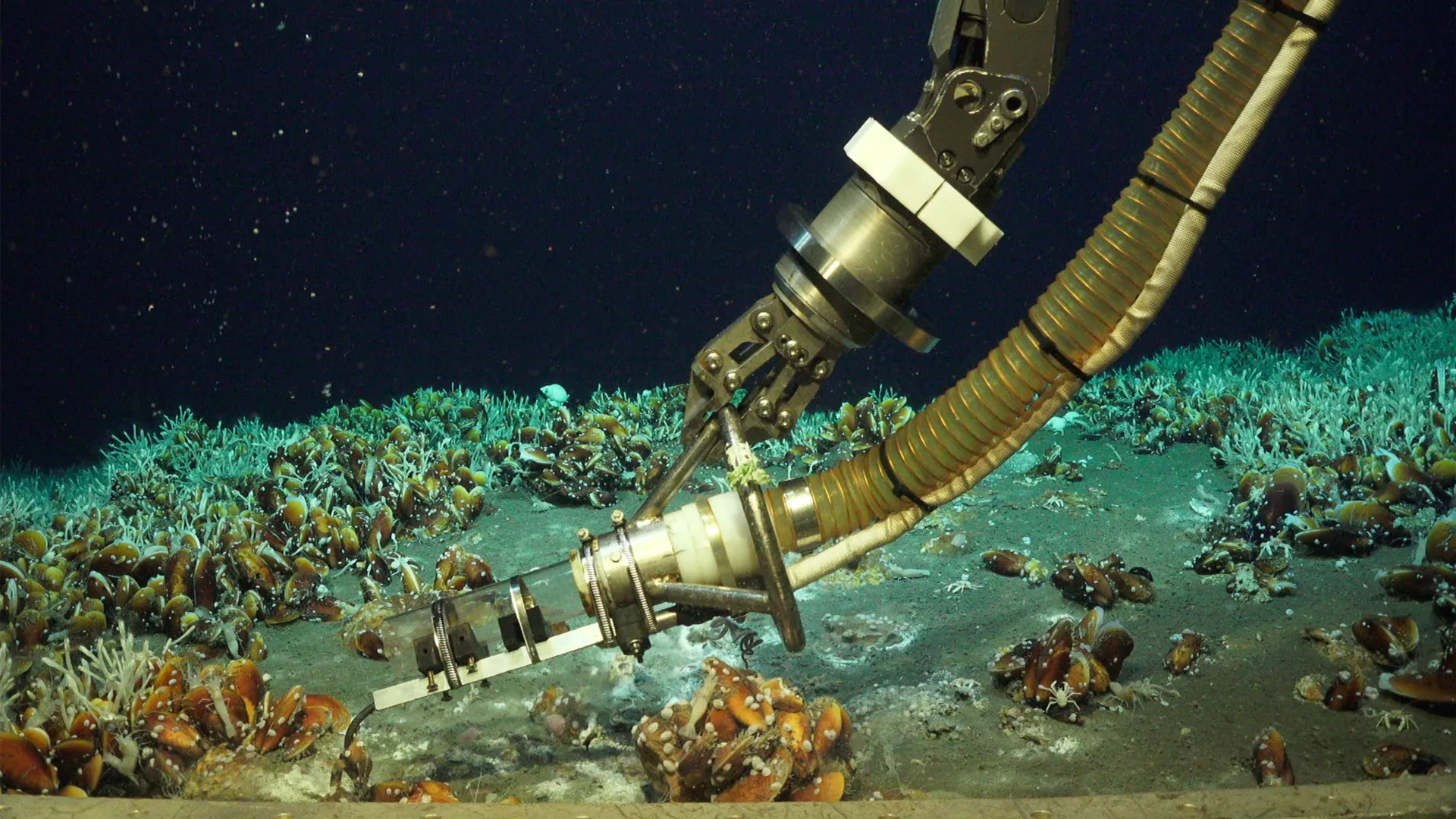Scientists discover a hidden deep sea hotspot bursting with life
- Date:
- November 26, 2025
- Source:
- Helmholtz Centre for Ocean Research Kiel (GEOMAR)
- Summary:
- Beneath the waters off Papua New Guinea lies an extraordinary deep-sea environment where scorching hydrothermal vents and cool methane seeps coexist side by side — a pairing never before seen. This unusual chemistry fuels a vibrant oasis teeming with mussels, tube worms, shrimp, and even purple sea cucumbers, many of which may be unknown to science. The rocks themselves shimmer with traces of gold, silver, and other metals deposited by past volcanic activity.
- Share:

Off the coast of Papua New Guinea, scientists have identified a previously unknown type of hydrothermal field where two different processes occur at the same time: hot hydrothermal fluids rise from below the seafloor while unusually large quantities of methane and other hydrocarbons escape from the sediments. This combination has not been documented anywhere else. The site is located about 1,300 meters deep on the slope of Conical Seamount in the western Pacific, near the island of Lihir in Papua New Guinea.
The findings were recently described in Scientific Reports.
ROV delivers the surprise
"We essentially have a hot vent bubbling right next to a cool gas seep -- a combination that has never been described before," says Dr. Philipp Brandl, marine geologist at the GEOMAR Helmholtz Centre for Ocean Research Kiel. He was chief scientist on the SONNE expedition SO299 DYNAMET, which surveyed the Tabar-Lihir-Tanga-Feni island chain in 2023 to investigate the region's underwater volcanoes (seamounts).
Brandl adds: "No one really expected to find a hydrothermal field here, let alone one that is so exceptional." Earlier missions had shown hints of limited hydrothermal activity, yet this field went unnoticed during several previous research cruises. Only when the team deployed the ROV Kiel 6000 did the unusual features of the site become clear. "It was a real surprise," Brandl says, "especially for those of us who had worked in this area multiple times."
A hybrid system of hot and cool vents
Hydrothermal vents and methane seeps typically appear in separate locations on the seafloor. In this instance, however, their close spacing results from the specific makeup of Conical Seamount. Thick layers of sediment rich in organic material lie beneath the volcanic edifice. Rising magma heats these buried layers, producing methane and other hydrocarbons. At the same time, the heat from the magma drives chemically rich fluids upward until they exit the seafloor as hot hydrothermal vents.
Both the heated fluids from below and the cooler, methane-filled gases from the sediments move upward through the same pathways. As a result, hot water and cold gas emerge from the seafloor only a few centimeters apart.
A habitat unlike any other
This unusual arrangement creates an entirely new kind of deep-sea environment that supports an exceptionally varied community of organisms. The rocks are densely covered by Bathymodiolus mussels, tube worms, shrimp, amphipods, and vivid purple sea cucumbers. "In places, you couldn't see a single patch of rock because everything is so densely populated," Brandl says. "We are confident that some of the species there have not yet been described. However, a dedicated expedition would be needed to fully study this unique habitat."
Because mussels dominate the area, the research team and local observer Stanis Konabe from the University of Papua New Guinea named the site 'Karambusel'. In Tok Pisin, the word means 'mussel'.
Traces of precious metals in the rock
The unusual mixture of gases at Karambusel affects both the ecosystem and the geological characteristics of the vent field. Methane levels exceed 80 percent, and hot fluids rising from below create distinctive chemical conditions in the subsurface. Gold and silver, along with arsenic, antimony, and mercury, accumulate in the surrounding rocks. These minerals indicate that the area once experienced high-temperature hydrothermal activity that deposited precious metals, even though current activity is cooler.
Threats from human activity
Although the site is remarkable for both its geology and its biology, it faces significant risks. Mining operations already occur nearby, such as at the Ladolam gold mine on Lihir, where waste material is discharged into the ocean. Additional exploration licences for seafloor minerals and hydrocarbons are in place. These activities pose threats to the delicate ecosystem and the organisms that depend on it.
The researchers urge further investigation of this region, along with careful marine spatial planning and protective measures to safeguard the site. Philipp Brandl states: "We have discovered an unexpected treasure trove of biodiversity in the Karambusel field that needs to be protected before economic interests destroy it."
Story Source:
Materials provided by Helmholtz Centre for Ocean Research Kiel (GEOMAR). Note: Content may be edited for style and length.
Journal Reference:
- Philipp A. Brandl, Sylvia G. Sander, Christoph Beier, Mark Schmidt, Jan J. Falkenberg, Terue Kihara, Klaas Meyn, Felix Genske, Rebecca Zitoun, Brent I. A. McInnes, Mark D. Hannington, Sven Petersen, Eemu J. Ranta, Fred Jourdan, Louis-Maxime Gautreau, Thor H. Hansteen, Ingo Heyde, Stanis Konabe, Joseph O. Espi, Octavio Acuña Avendaño, Alan T. Baxter, Christophe Y. Galerne, Max Kaufmann, Johanna Klein, Sabine Lange, Doris Maicher, Esther Panachi, Konstantin Reeck, Egor Riemer, William Ruth, Johanna Schenk, Sarima Vahrenkamp, Leon Waßmund, Julia Wenske, Hannah Zimmer. Coupled hydrothermal venting and hydrocarbon seepage discovered at Conical Seamount, Papua New Guinea. Scientific Reports, 2025; 15 (1) DOI: 10.1038/s41598-025-17192-x
Cite This Page: